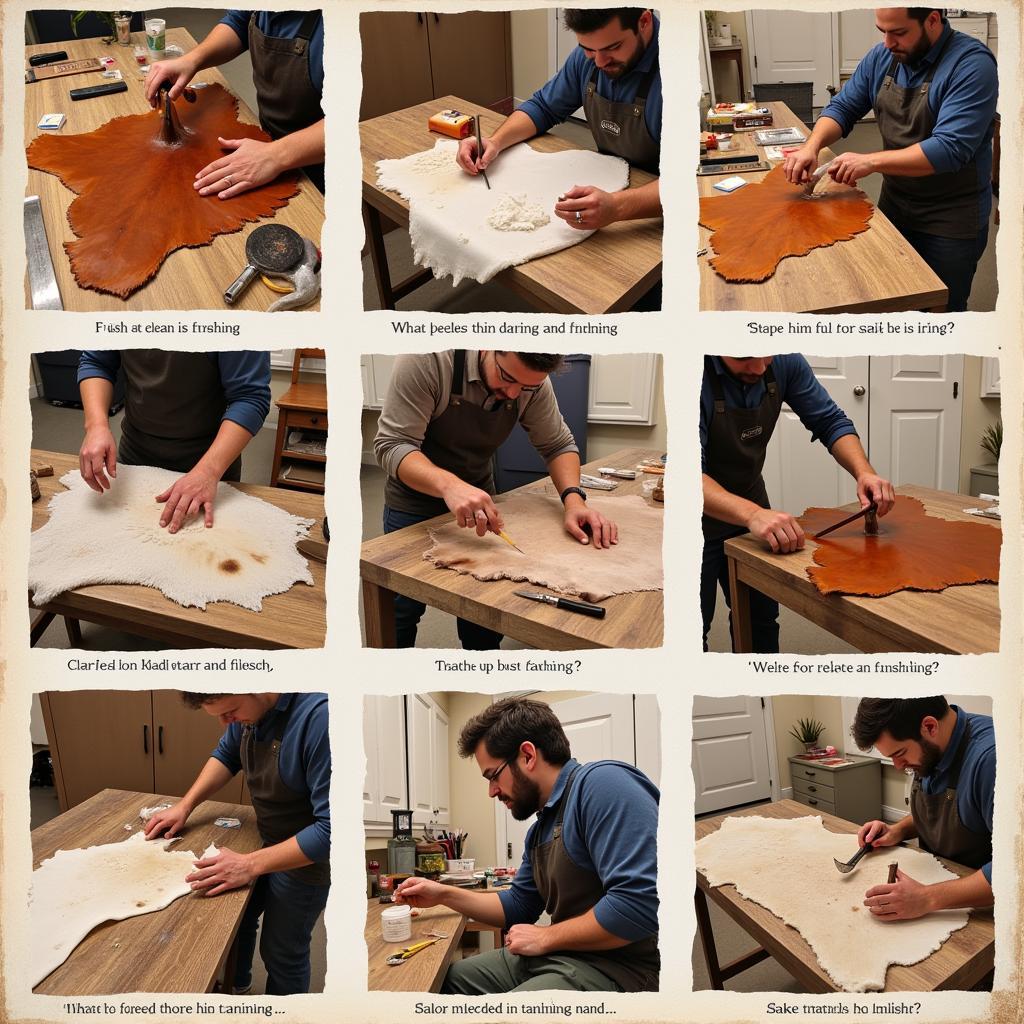Horse Hides are a byproduct of the equine industry, often raising questions about their sourcing and utilization. This article delves into the various aspects of horse hides, from their practical uses to the ethical considerations surrounding their acquisition and processing. We’ll explore the different applications of horse hides, discuss proper care techniques, and address common concerns about their origin.  Horse Hide Tanning Process
Horse Hide Tanning Process
The Versatility of Horse Hides
Horse hides have been used for centuries for a variety of purposes, owing to their durability and unique characteristics. Traditionally, they were essential for creating strong and weather-resistant clothing, footwear, and shelters. Today, horse hide leather remains a sought-after material for crafting high-quality goods. From sturdy work boots to fashionable horse leather pants, horse hide offers a blend of practicality and aesthetic appeal. Their inherent strength makes them ideal for items that need to withstand wear and tear, such as saddles and other equestrian equipment.
Exploring the Different Uses of Horsehide
Horse hides find applications in a surprising range of products, showcasing their versatility. These include:
- Fashion: Jackets, bags, belts, and wallets benefit from the unique grain and texture of horse leather.
- Equestrian Equipment: Saddles, bridles, and other tack often incorporate horse hide for its strength and durability.
- Home Decor: Rugs, wall hangings, and furniture upholstery can feature horse hide as a distinctive and luxurious element.
- Musical Instruments: Drumheads made from horse hide are known for their resonant qualities.
Ethical Sourcing and Sustainability
The origin of horse hides is a crucial aspect to consider. Justus Horses USA strongly advocates for ethical sourcing and transparency within the industry. We believe in responsible practices that prioritize the well-being of horses. This includes supporting suppliers who adhere to strict guidelines regarding animal welfare and humane treatment.
Ensuring Responsible Practices
Understanding the source of horse hides is paramount. Ask questions, research suppliers, and look for certifications that guarantee ethical treatment. Choosing products made from responsibly sourced horse hides supports a sustainable industry and promotes animal welfare. What are some questions you should ask about the sourcing of horse hides? Consider inquiring about the horse’s life, its treatment, and the overall practices of the farm or supplier.
Dr. Emily Carter, DVM, specializing in equine welfare, emphasizes, “Transparency and traceability are key to ensuring ethical sourcing of horse hides. Consumers should feel empowered to ask questions and demand accountability from suppliers.”
Caring for Horse Hide Products
Maintaining the quality and longevity of horse hide products requires proper care. Regular cleaning and conditioning are essential for preserving the leather’s suppleness and preventing cracking. Avoid exposing horse hide to excessive moisture or direct sunlight, which can damage the material.
Tips for Cleaning and Conditioning
- Use a damp cloth to wipe away dirt and grime.
- Apply a leather conditioner specifically designed for horse hide.
- Store horse hide products in a cool, dry place away from direct sunlight.
- Consider professional cleaning for delicate or intricate items.
Conclusion: Appreciating the Value of Horse Hides
Horse hides, when sourced responsibly, offer a unique and versatile material for a wide range of products. From horse leather wallet to horse saddles colors, the possibilities are extensive. By understanding the ethical considerations and proper care techniques, we can appreciate the value of horse hides while promoting sustainable practices.
FAQ
- Are all horse hides from slaughtered horses? Not necessarily. Some hides come from horses that have died of natural causes.
- Is horse hide leather durable? Yes, horse hide is known for its strength and durability.
- How can I tell if horse hide is genuine? Look for unique grain patterns and consult a leather expert.
- What is the difference between horse hide and cowhide? Horse hide is generally thicker and more durable than cowhide.
- Can horse hide be dyed different colors? Yes, horse hide can be dyed various colors.
- Is horse hide expensive? Generally, horse hide is considered a premium leather and can be more expensive than other types of leather.
- What are some alternatives to horse hide leather? Cowhide, buffalo hide, and synthetic leather are common alternatives.
If you need assistance, please contact us by Phone: 0772127271, Email: [email protected] or visit us at QGM2+WX2, Vị Trung, Vị Thuỷ, Hậu Giang, Việt Nam. We have a 24/7 customer service team. Also check out our leather horse figurine and horse by products.